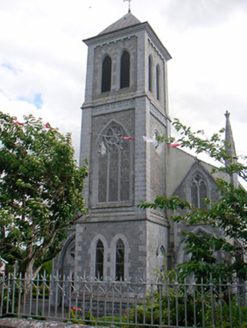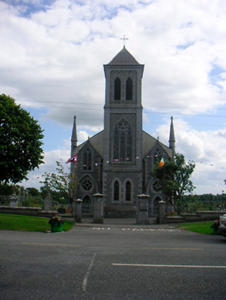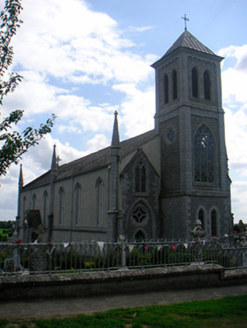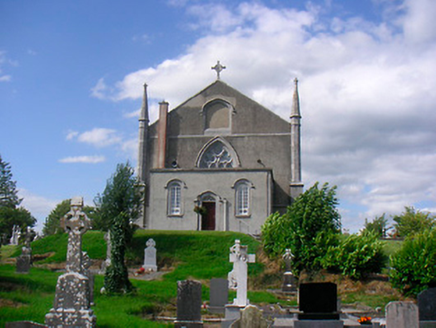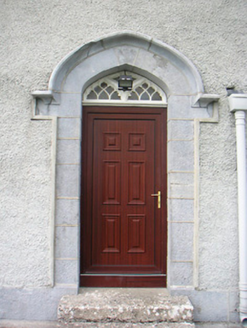Survey Data
Reg No
15315003
Rating
Regional
Categories of Special Interest
Architectural, Artistic, Social, Technical
Original Use
Church/chapel
In Use As
Church/chapel
Date
1840 - 1880
Coordinates
221190, 248933
Date Recorded
22/07/2004
Date Updated
--/--/--
Description
Detached Roman Catholic church in a Tudor-Gothic style, built c.1845, with later Early English Gothic style alterations c.1870. Comprises six-bay nave with an attached three-stage tower on square-plan to north with slated pyramidal roof, flanked to east and west by advanced gable-fronted bays containing main entrances. Single-storey flat-roofed sacristy to rear (south) and single-bay single-storey entrance porch to east side of nave. Detached Roman Catholic church in a Tudor-Gothic style, built c.1845, with later Early English Gothic style alterations c.1870. Entrance façade (north) comprises a three-stage tower (on square-plan) to the centre having a slated pyramidal roof over, flanked to the east and the west by advanced gable-fronted bays containing the main entrances. Six-bay side elevations to the nave (south). Single-storey flat-roofed sacristy to rear (south) and single-bay single-storey entrance porch to east side of nave. Pitched natural slate roof with decorative ridge tiles and cast-iron rainwater goods. Cut stone Celtic cross finial above chancel gable. Front section (north) built of rubble limestone with ashlar trim and detailing. Roughcast rendered walls to nave with ashlar trim, including continuous sill course and three ashlar limestone pinnacled buttresses to east and west. Roughcast rendered sacristy to rear. Pointed-arched openings to nave with multi-paned timber casement windows and with hoodmouldings over, four-light window with Geometric tracery to chancel gable with pointed-segmental-headed blind niche above. Triple-light window with Decorated Gothic tracery to second stage of tower with paired lancet windows below and paired lancet openings above to belfry. Pointed-arched entrances with timber panelled doors to advanced bays on either side of tower (east and west) with wheel/rose windows above, set in pointed-arched recesses. Paired lancets above to advanced gables. Tudor-arched doorcase to sacristy (south). Interesting interior with timber Gothic rib-vaulted roof, decorative plasterwork and a collection of mid-to-late-nineteenth century memorials, the earliest dating to 1841. Set back from line of road in own grounds with tarmacadam forecourt to north and graveyard to east and west. Gateway to north comprising pair of limestone ashlar piers on square-plan with ashlar coping and cast-iron gates, flanked by similarly-styled pedestrian entrances and sections of low rendered walling with cut limestone coping and decorative cast-iron railings over. Located to the west end of Ballymore Village.
Appraisal
An attractive and unusual church, which retains its early form and character. Described by Casey and Rowan (1993, 146) as 'a curious hybrid of vernacular mid nineteenth-century Tudor-Gothic and Early English Gothic styles', this is an imposing building which reflects changing architectural tastes and aspirations over an extended construction period. The combination of the rendered walls to the nave with the rubble limestone front section and the ashlar window and door surrounds, creates an interesting textural variation. The unusual mixture of window styles, along with the ornate entrance doors, also adds an artistic quality to the church's façade. The open bright interior also retains much of its original detail and character, including an attractive collection of marble memorials of artistic merit. This church, which replaced an earlier T-plan church on the same site, is known locally as the 'Famine Church' as construction started during the early stages of the Great Famine (1845-1850). However, the church was not completed until the local parish priest returned from a trip to America with funding, c.1880. This church represents one of the largest building projects undertaken by the Catholic Church in Co. Westmeath in the first decades following Emancipation (1829) and remains an important element in the architectural heritage of Westmeath. The good gate piers and boundary railings to the north and the collection of gravestones to the east and west complete the setting. This church is located in an elevated location to the north end of Ballymore, dominating the local skyline and surrounding buildings.
